Remove the crankshaft position sensor (CKPS) (C).
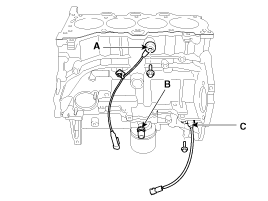
Engine removal is required for this procedure.
Use fender covers to avoid damaging painted surfaces.
To avoid damaging the cylinder head, wait until the engine coolant temperature drops below normal temperature before removing it.
When handling a metal gasket, take care not to fold the gasket or damage the contact surface of the gasket.
To avoid damage, unplug the wiring connectors carefully while holding the connector portion.
Mark all wiring and hoses to avoid misconnection.
Turn the crankshaft pulley so that the No.1 piston is at TDC (Top dead center).
Remove the engine assembly from the vehicle.
(Refer to Engine And Transaxle Assembly - “Engine And Transaxle Assembly”)
Remove the transaxle assembly from the engine assembly.
Manual Transaxle
(Refer to Manual Transaxle System - "Manual Transaxle")
Automatic Transaxle
(Refer to Automatic Transaxle System - "Automatic Transaxle")
Manual Transaxle : Remove the flywheel.
(Refer to Cylinder Block - "Flywheel")
Automatic Transaxle : Remove the drive plate.
(Refer to Cylinder Block - "Drive Plate")
Remove the rear oil seal.
(Refer to Cylinder Block - “Rear Oil Seal”)
Install the engine to engine stand for disassembly.
Remove the timing chain.
(Refer to Timing System - “Timing Chain”)
Remove the water pump assembly.
(Refer to Cooling System - “Water Pump”)
Remove the water inlet fitting and the thermostat assembly.
(Refer to Cooling System - “Thermostat“)
Remove the intake manifold.
(Refer to Intake And Exhaust System - "Intake Manifold")
Remove the A/C compressor.
(Refer to Heating, Ventilation Air conditioning -"Compressor")
Remove the exhaust manifold.
(Refer to Intake And Exhaust System - "Exhaust Manifold")
Remove the cylinder head assembly.
(Refer to Cylinder Head Assembly - "Cylinder Head")
Remove the oil filter.
(Refer to Lubrication System - “Engine Oil”)
Remove the oil screen.
(Refer to Lubrication System - “Oil Pan”)
Remove the knock sensor (A).
Remove the oil pressure switch (OPS) (B).
Remove the crankshaft position sensor (CKPS) (C).

Check the connecting rod side clearance.
Check the connecting rod bearing cap oil clearance.
Remove the piston and connecting rod assemblies.
Using a ridge reamer, remove all the carbon from the top of the cylinder.
Remove the connecting rod bearing caps (A).
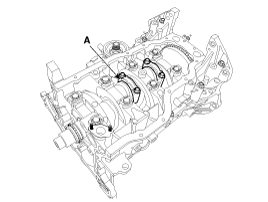
Mark the connecting rod, and caps to be able to reassemble in the original position and direction.
Push the piston and connecting rod assembly with upper bearing through the top of the cylinder block.
Keep the connecting rod ands cap with their bearings assembled together.
Arrange the piston and connecting rod assemblies in the correct order.
Mark the piston and connecting rod assemblies to be able to reassemble in the original position.
Check fit between piston and piston pin.
Try to move the piston back and forth on the piston pin.
If any movement is felt, replace the piston and pin as a set.
Remove piston rings.
Using a piston ring expander, remove the 2 compression rings.
Remove 2 side rails and the oil ring by hand.
Arrange the piston rings in the correct order.
Disassemble the connecting rod from the piston.
Remove the snap ring (A) from the piston.
Remove the piston pin (B) from piston.
Disassemble the piston (C) and connecting rod (D).
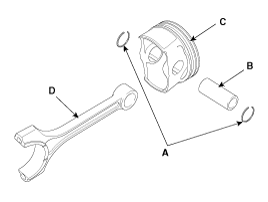
Check the connecting rod side clearance.
Using a feeler gauge, measure the end play while moving the connecting rod back and forth.
If out-of-tolerance, install a new connecting rod.
If still out-of-tolerance, replace the crankshaft.
Side clearance
Standard: 0.10~ 0.25 mm (0.0039 ~ 0.0098 in.)

Check the connecting road bearing oil clearance.
Check the matchmarks on the connecting rod and cap are aligned to ensure correct reassembly.
Remove 2 connecting rod cap bolts.
Remove the connecting rod cap and lower bearing.
Clean the crank pin and bearing.
Place a plastigage across the crankshaft pin journal.
Reinstall the lower bearing and cap, and torque the bolts.
Tightening torque
1st step:
17.7 ~ 21.6 N.m (1.8 ~ 2.2 kgf.m, 13.0 ~ 15.9 lb-ft)
2nd step: 88 ~ 92°
Do not turn the crankshaft.
Do not turn the crankshaft.
Do not reuse the connection rod cap bolts.
Remove the connecting rod cap and lower bearing.
Measure the width of the plastigage at its widest point.
Oil clearance:
0.028 ~ 0.046 mm (0.00110 ~ 0.00181 in.)

If the measurement from the plastigage is too wide or too narrow, remove the upper and lower bearing and then install new bearings with the same color mark. Recheck the oil clearance.
Do not file, shim, of scrape the bearings or the caps to adjust clearance.
If the plastigage shows the clearance is still incorrect, try the next larger or smaller bearing. Recheck the oil clearance.
If the proper clearance cannot be obtained by using the appropriate larger or smaller bearings, replace the crankshaft and repeat the check procedure.
If the marks are indecipherable because of an accumulation of dirt and dust, do not scrub them with a wire brush or scraper. Clean them only with solvent or detergent.

Class | Mark | Inside Diameter |
0 | A | 48.000 ~ 48.006 mm (1.88976 ~ 1.89000 in.) |
1 | B | 48.006 ~ 48.012 mm (1.89000 ~ 1.89023 in.) |
2 | C | 48.012 ~ 48.018 mm (1.89023 ~ 1.89047 in.) |

Conform to read stamping order as shown arrow direction from #1.
Class | Mark | Outside Diameter Of Pin |
I | 1 | 44.966 ~ 44.972 mm (1.77031 ~ 1.77055 in.) |
II | 2 | 44.960 ~ 44.966 mm (1.77008 ~ 1.77031 in.) |
III | 3 | 44.954 ~ 44.960 mm (1.76984 ~ 1.77008 in.) |

Class | Mark | Thickness Of Bearing |
A | Blue | 1.509 ~ 1.512 mm (0.05941 ~ 0.05953 in.) |
B | Black | 1.506 ~ 1.509 mm (0.05929 ~ 0.05941 in.) |
C | None | 1.503 ~ 1.506 mm (0.05917 ~ 0.05929 in.) |
D | Green | 1.500 ~ 1.503 mm (0.05906 ~ 0.05917 in.) |
E | Yellow | 1.497 ~ 1.500 mm (0.05894 ~ 0.05906 in.) |
Select a connecting rod bearing using selection chart.
Assembling Classification Of Bearing | Connecting Rod Identification Mark | |||
0 (A) | 1 (B) | 2(C) | ||
Crankshaft Identification Mark | I (1) | E (Yellow) | D (Green) | C (None) |
II (2) | D (Green) | C (None) | B (Black) | |
III (3) | C (None) | B (Black) | A (Blue) | |
Check the connecting rods.
When reinstalling, make sure that cylinder numbers put on the connecting rod and cap at disassembly match. When a new connecting rod is installed, make sure that the notches for holding the bearing in place are on the same side.
Replace the connecting rod if it is damaged on the thrust faces at either end. Also if step wear or a severely rough surface of the inside diameter of the small end is apparent, the rod must be replaced as well.
Using a connecting rod aligning tool, check the rod for bend and twist. If the measured value is close to the repair limit, correct the rod by a press. Any connecting rod that has been severely bent or distorted should be replaced.
Allowable bend of connecting rod:
0.05 mm (0.0020 in.) or less for 100 mm (3.94 in.)
Allowable twist of connecting rod:
0.10 mm (0.0039 in.) or less for 100 mm (3.94 in.)
When the connecting rods are installed without bearings, there should be no difference on side surface.
Clean piston.
Using a gasket scraper, remove the carbon from the piston top.
Using a groove cleaning tool or broken ring, clean the piston ring grooves.
Using solvent and a brush, thoroughly clean the piston.
Do not use a wire brush.
Check the piston-to-cylinder clearance by calculating the difference between the cylinder bore inner diameter and the piston outer diameter.
Piston-to-cylinder clearance:
0.02 ~ 0.04 mm (0.0008 ~ 0.0016 in.)
Using a cylinder bore gauge, measure the cylinder bore diameter at position in the thrust and axial direction.
Cylinder bore diameter:
81.00 ~ 81.03 mm (3.1890 ~ 3.1902 in.)
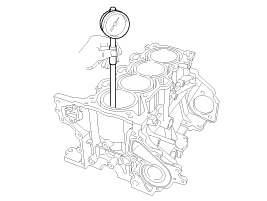
Measure position points (from the top of the cylinder block):
30 mm (1.1811 in.) / 60 mm (2.3622 in.) / 90 mm (3.5433 in.)
Measure the piston outside diameter at 35 mm (1.3780 in) from top land of the piston.
Piston outside diameter:
80.97 ~ 81.00 mm (3.1878 ~ 3.1890 in.)

Select the piston matching with cylinder bore class.
Check the cylinder bore size code on the cylinder block side surface.

Size Code | Cylinder Bore Inner Diameter |
A | 81.00 ~ 81.01 mm (3.1890 ~ 3.1894 in.) |
B | 81.01 ~ 81.02 mm (3.1894 ~ 3.1898 in.) |
C | 81.02 ~ 81.03 mm (3.1898 ~ 3.1902 in.) |
Check the piston size mark on the piston top face.

Size Code | Piston Outer Diameter |
A | 80.97 ~ 80.98 mm (3.1878 ~ 3.1882 in.) |
B | 80.98 ~ 80.99 mm (3.1882 ~ 3.1886 in.) |
C | 80.99 ~ 81.00 mm (3.1886 ~ 3.1890 in.) |
Inspect the piston ring side clearance.
Using a feeler gauge, measure the clearance between new piston ring and the wall of ring groove.
If the clearance is greater than maximum, replace the piston.
Piston ring side clearance
[Standard]
No.1 ring:
0.040 ~ 0.080 mm (0.00157 ~ 0.00315 in.)
No.2 ring:
0.040 ~ 0.080 mm (0.00157 ~ 0.00315 in.)
Oil ring:
0.020 ~ 0.060 mm (0.00079 ~ 0.00236 in.)

If the clearance is greater than maximum, replace the piston.
Inspect piston ring end gap.
To measure the piston ring end gap, insert a piston ring into the cylinder bore. Position the ring at right angles to the cylinder wall by gently pressing it down with a piston. Measure the gap with a feeler gauge.
Piston ring end gap
[Standard]
No.1 ring: 0.15 ~ 0.30 mm (0.0059 ~ 0.0118 in.)
No.2 ring: 0.30 ~ 0.45 mm (0.0118 ~ 0.0177 in.)
Oil ring : 0.20 ~ 0.50 mm (0.0079 ~ 0.0197 in.)

If the gap exceeds the service limit, replace the piston rings. If the gap is too large, recheck the cylinder bore inner diameter. If the bore is over the service limit, the cylinder block must be replaced.
Measure the diameter of the piston pin.
Piston pin diameter:
19.996 ~ 20.000 mm (0.78724 ~ 0.78740 in.)

Measure the piston pin-to-piston clearance.
Piston pin-to-piston clearance:
0.004 ~ 0.013 mm (0.00016 ~ 0.00051 in.)
Check the clearance between the piston pin outer diameter and the connecting rod small end inner diameter.
Piston pin-to-connecting rod clearance:
0.007 ~ 0.017 mm (0.00028 ~ 0.00067 in.)
Thoroughly clean all parts to be assembled.
Before installing the parts, apply fresh engine oil to all sliding and rotating surfaces.
Assemble the piston and the connecting rod.
Install the snap ring (A) in one side of the piston pin hole.
Align the piston front mark and the connecting rod front mark.
Insert the piston pin (B) into the piston pin hole and the small end bore of connecting rod.
Install the snap ring (C) in the other side after inserting the piston pin.
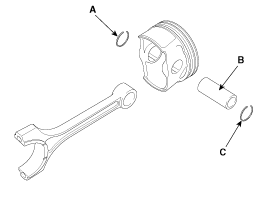
Apply a sufficient amount of engine oil to outer surface of the piston, inner surface of piston pin hole and small end bore of the connecting rod before inserting the piston pin.
Be careful not to damage and scratch the small end bore, piston pin hole and piston pin when inserting the piston pin.
Set the snap ring firmly so that the snap ring can contact with the whole groove of the piston pin hole.
Install the piston rings.
Install the oil ring spacer and 2 side rails by hand.
Using a piston ring expander, install the 2 compression rings with the maker mark facing upward.
Position the piston rings so that the ring ends are as shown. (The No.1 ring should be on the opposite side of the No.2 ring.)
Example)
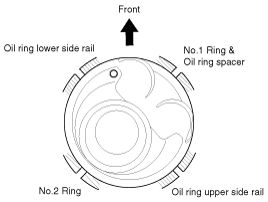
Check to ensure that the oil ring can be turned smoothly.
Install the connecting rod bearings.
Align the bearing claw with the groove of the connecting rod or connecting rod cap.
Install the bearings (A) in the connecting rod and connecting rod cap (B).
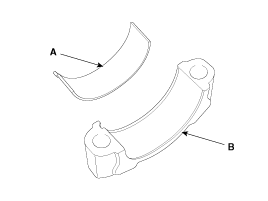
Be careful not to change the position of bearing caps.
Install the piston and connecting rod assemblies.
Before installing the piston, apply a coat of engine oil to the ring grooves and cylinder bores.
Install the piston and connecting rod assembly with the front marks facing the front of the engine.
Install the ring compressor, check that the rings are securely in place, and then position the piston in the cylinder, and tap it in using the wooden handle of a hammer.
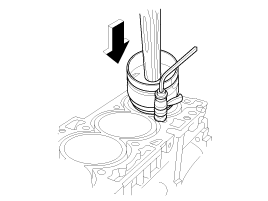
Stop after the ring compressor pops free, and check the connecting rod-to-crank journal alignment before pushing the piston into place.
Apply engine oil to the bolt threads. Install the rod caps with bearings, and tighten the bolts.
Tightening torque
1st step :
17.7 ~ 21.6 N.m (1.8 ~ 2.2 kgf.m, 13.0 ~ 15.9 lb-ft)
2nd step : 88 ~ 92°
Using the SST (09221-4A000), tighten the connecting rod cap bolts.
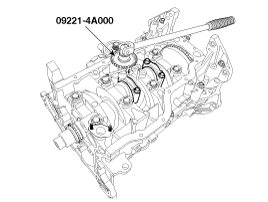
Do not reuse the connecting rod cap bolts.
Maintain downward force on the ring compressor to prevent the rings from expending before entering the cylinder bore.
Check the connecting rod end play.
Assemble the other parts in the reverse order of disassembly.